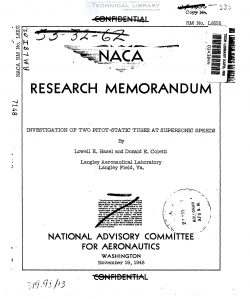naca-rm-l8i02
- Version
- 83 Downloads
- 852.62 KB File Size
- 1 File Count
- April 26, 2017 Create Date
- April 26, 2017 Last Updated
National Advisory Committee for Aeronautics, Research Memorandum - Investigation of Two Pivot-Static Tubes at Supersonic Speeds

Tests have been.conducted in the Langley 9-inch supersonic tunnel
of two pitot-static tubes to measure at several angles of attack the
body static pressures and indicated Mach numbers. A cylindrical tube
with an ogival nose section 8 body diameters long was tested. at a
free-stream Mach number of 1.9% A service pitot-static tube was
tested. at free-stream Mach numbers of 1.93 and 1.62.
The axial pressure distribution on the cylindrical body was
independent of position at zero angle of attack provided that the
measurements were made 8 or more body diameters behind the end of the
nose section. The radial pressure distribution on the forward side
of the cylindrical tube was—in fair agreement at small angles of
attack with that calculated by an approximate theory.
The service pitot-static tube gave results which were nearly
independent of small angles of attack in pitch but which varied
appreciably with yaw angle. The indicated Mach number at zero angle
of attack for a test Mach number of 1.93 was 1.95; for a test Mach
number of l. 62, the indicated Mach number was 1.62.
The design of suitable tubes or other devices for mea
pressures corresponding to supersonic flight Mach numbers
and. missiles appears of importance at the present time. S ch a device
should be capable of measuring the free-stream static pressure as the 1-3-
stagnation pressure after a normal shock. Accurate stagnation pressures é.-
are easily obtained; however, the ability to measure the static pressure"
appears mere uncertain. It is indicated from theoretical calculatidhs
that if an ogival-nose, cylindrical body is placed in a. supersonic air
stream at zero angle of attack, the static pressures on the body will
at some station doimstream of the nose return to free-stream static
pressure. The length of the cylindrical body required for the static
pressure to return to free-stream pressure is dependent primarily upon
nose shape and Mach number. In an att . to determine this length,
experimental tests on an ogival-nose, cylindrical pitot-static tube
have been made in the Langley 9-inch supersonic tunnel. at a Mach number
of 1.94. Static pressures were measured on_the cylindrical body'h, 8,
12, 16, and 20 body diameters behind the endof the nose section.
| File | Action |
|---|---|
| naca-rm-l8i02 Investigation of Two Pivot-Static Tubes at Supersonic Speeds.pdf | Download |

Comment On This Post